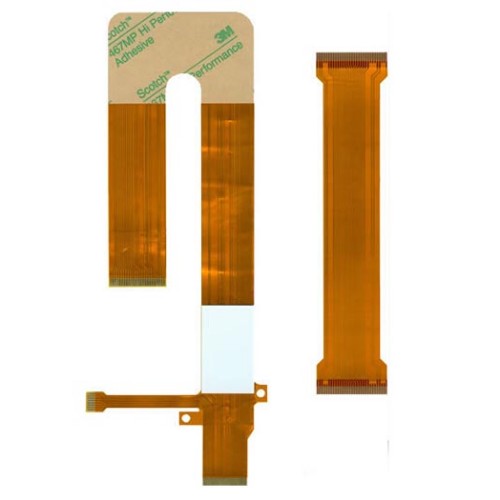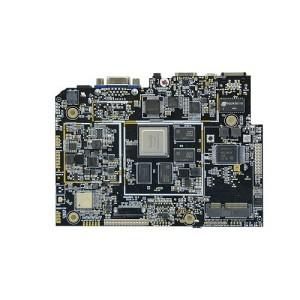Description

"Flexible Printed Circuit Connectors" refers to connectors specifically designed to interface with flexible printed circuits (FPCs). These connectors provide a connection point between an FPC and other components or circuits, allowing for the transmission of electrical signals and power. They are often used in various electronic devices to establish reliable and flexible connections within a compact space.
What is FPC?
FPC is the abbreviation of Flexible Printed Circuit, which means "flexible printed circuit". It is a kind of printed circuit board made of flexible insulating substrate, with the characteristics of being bendable, foldable, and twistable. It can adapt to various complex spaces and shape requirements and is widely used in electronic devices such as mobile phones, tablet computers, digital cameras, etc.
The fabrication process of Flexible Printed Circuits (FPCs) typically involves the following steps:
1. Flexible Printed Circuits (FPCs) Design and layout: The circuit design is created using specialized software, taking into account the flexibility requirements, component placement, and routing.
2. Substrate selection of Flexible Printed Circuits (FPCs): A flexible substrate material, such as polyimide (PI) or polyester (PET), is chosen based on the application's specific needs in terms of temperature resistance, flexibility, and other properties.
3. Flexible Printed Circuits Copper deposition: A thin layer of copper is deposited onto the substrate. This can be done through methods like electroplating or sputtering.
4. FPC Photolithography: A photosensitive resist is applied to the copper layer, and a photomask is used to expose the areas where the copper is to be retained. The unexposed resist is then removed, leaving a pattern of copper on the substrate.
5. The Etching of Flexible Printed Circuits : The exposed copper is etched away using an appropriate chemical etchant, leaving the desired circuit pattern.
6. Flexible Printed Circuits Cover layer application: A protective cover layer, often made of polyimide or other insulating materials, is applied to protect the circuits and enhance reliability.
7. FPC hole drilling: Holes are drilled for component mounting and interconnections.
8. Flexible Printed Circuits Plating and surface finish: The exposed copper pads and holes may undergo plating processes like gold, nickel, or tin to improve conductivity and solderability. A surface finish is applied to protect the copper and enhance the board's performance.
9. Flexible Printed Circuits Testing and inspection: The fabricated FPCs are tested for electrical continuity, impedance, and other parameters to ensure they meet the quality standards.
10. FPC Final assembly: Components are soldered or attached to the FPC to complete the assembly.
The fabrication process requires precise control and specialized equipment to ensure the quality and performance of the resulting FPC.
Compared with PCB (Printed Circuit Board), FPC (Flexible Printed Circuit) has the following advantages and disadvantages:
Advantages of FPC:
1. Flexibility: Flexible Printed Circuits (FPCs) is highly flexible and can be bent, folded, or twisted to fit into complex and space-constrained designs. This flexibility allows for greater design freedom and enables the creation of unique form factors in electronic devices.
2. Lightweight: FPCs are generally lighter in weight compared to traditional PCBs, making them suitable for portable and lightweight electronic products.
3. High-density interconnectivity: FPC can accommodate a higher density of circuits and connections in a smaller area, facilitating the miniaturization of electronic devices.
4. Better signal integrity: Due to their flexibility and reduced impedance mismatches, Flexible Printed Circuits (FPCs) can provide better signal transmission and lower signal loss, especially at high frequencies.
5. Reduced assembly time and cost: Flexible Printed Circuits (FPCs) can be integrated into the final product more easily, reducing the assembly time and overall manufacturing costs.
Disadvantages of FPC:
1. Limited current-carrying capacity: Flexible Printed Circuits (FPCs) typically have a lower current-carrying capacity compared to rigid PCBs, which may limit their use in applications with high-power requirements.
2. Higher cost: The production process of Flexible Printed Circuits (FPCs) is often more complex and requires specialized materials and manufacturing techniques, resulting in a higher cost per unit compared to standard PCBs.
3. Less mechanical strength: While flexible, FPCs are not as mechanically strong as rigid PCBs and may be more susceptible to damage during handling or in harsh environments.
4. Thermal management challenges: Heat dissipation can be more difficult in Flexible Printed Circuits (FPCs) due to their thinner construction and limited ability to attach heat sinks or cooling components.
5. Design complexity: Designing Flexible Printed Circuits (FPCs) requires specific knowledge and tools to account for the flexibility and unique characteristics, which can increase the design complexity and time.
The applications of FPC (Flexible Printed Circuit) are extensive. Here are some common fields:
1. Consumer electronics: Such as smart phones, tablets, and laptops. Flexible Printed Circuits (FPCs) is used to connect components such as displays, cameras, buttons, batteries, etc. Due to its flexibility, it can adapt to the compact design and thinness requirements of the devices.
2. Automotive electronics: Flexible Printed Circuits (FPCs) is applied in the dashboard, center console, seats, sensors, and lighting systems of vehicles, and can achieve reliable circuit connections within the limited space of the vehicle.
3. Medical devices: For example, portable medical instruments, pacemakers, blood glucose meters, etc. The small size and flexibility of Flexible Printed Circuits (FPCs) contribute to the portability of the devices and their conformity to the human body.
4. Aerospace: FPCs is used in various electronic systems in aircraft and spacecraft, meeting their strict requirements for lightweight and high reliability.
5. Industrial control: Flexible Printed Circuits (FPCs) plays a role in automated production equipment, robots, testing instruments, etc., adapting to complex industrial environments and the needs of mechanical movements.
6. Communication equipment: Flexible Printed Circuits (FPCs) include routers, switches, base stations, etc., ensuring high-speed signal transmission and the compact layout of the equipment.
In conclusion, the characteristics of FPC make it widely used in many fields that require miniaturization, lightweight, flexibility, and high-reliability circuit connections.
FPC (Flexible Printed Circuit Board) and rigid circuit boards mainly have the following differences:
1. Physical characteristics:
- Flexibility: FPC has good flexibility and can be bent, folded, and twisted to adapt to various complex shapes and space limitations. Rigid circuit boards, on the other hand, are hard and not easy to bend.
- Thickness: Flexible Printed Circuits (FPCs) is usually thinner, which helps reduce the weight of the device and save space. Rigid circuit boards are relatively thicker.
2. Application scenarios:
- Flexible Printed Circuits (FPCs) is often used in devices that require frequent movement, bending, or have limited space, such as mobile phones, the folding parts of laptops, wearable devices, etc. Rigid circuit boards are more suitable for fixed devices that have higher requirements for stability and support, such as desktop computers, large appliances, etc.
3. Manufacturing process:
- The manufacturing process of Flexible Printed Circuits (FPCs) is relatively complex and requires special materials and processing methods to achieve its flexibility. The manufacturing process of rigid circuit boards is relatively mature and simple.
4. Cost:
- Generally speaking, the cost of Flexible Printed Circuits (FPCs) is usually higher than that of rigid circuit boards, especially in large-scale production.
5. Heat dissipation performance:
- Rigid circuit boards usually have better heat dissipation performance because their larger area and thicker structure are conducive to heat dissipation. The heat dissipation capacity of FPC is relatively weak.
6. Maintenance difficulty:
- Due to the complex structure of Flexible Printed Circuits (FPCs), maintenance and replacement may be more challenging. The maintenance of rigid circuit boards is relatively easier.
Both FPC (Flexible Printed Circuit) and PCB (Printed Circuit Board) have their own complexities and potential error-prone points in the manufacturing process. However, in general, FPC manufacturing may be more prone to errors due to the following reasons:
1. The flexible nature of Flexible Printed Circuits (FPCs) requires more precise handling and processing of the substrate material. Any mishandling during material handling, such as stretching or creasing, can lead to defects.
2. The process of forming fine circuits on the flexible substrate can be challenging. Maintaining the accuracy and consistency of the circuit pattern is crucial, and any deviations can cause electrical connection issues.
3. The lamination and bonding processes in Flexible Printed Circuits (FPCs) manufacturing need to ensure a perfect adhesion between different layers. Imperfect bonding can lead to delamination and reduced reliability.
4. Flexible Printed Circuits (FPCs) often involves more complex design requirements, especially for applications with high flexibility and tight space constraints. Errors in the design stage can be more difficult to rectify during manufacturing.
That said, PCB manufacturing also has its own set of challenges and potential error sources, such as ensuring accurate drilling, plating, and component placement. The ease of error occurrence can also depend on specific design requirements, manufacturing facilities, and operator skills.






